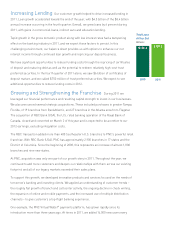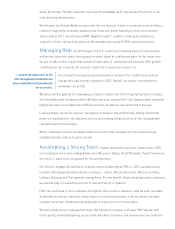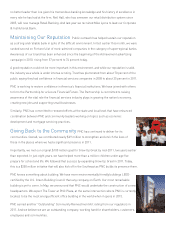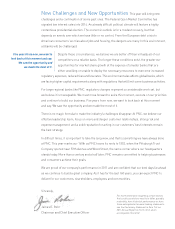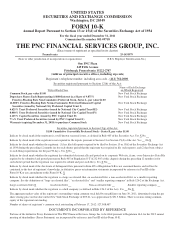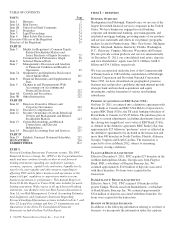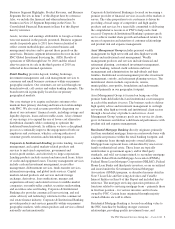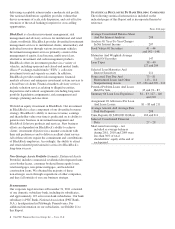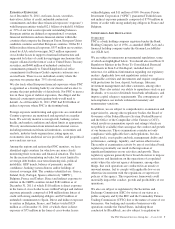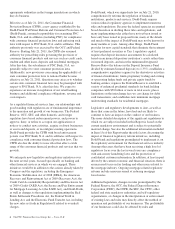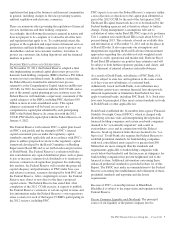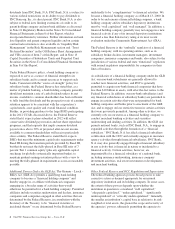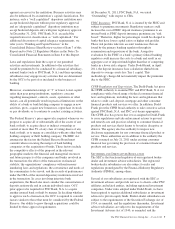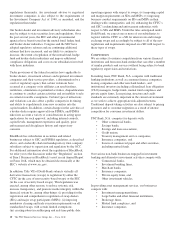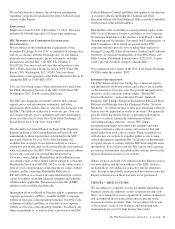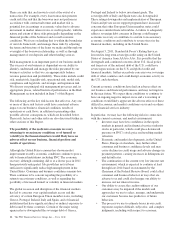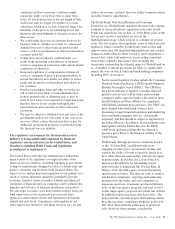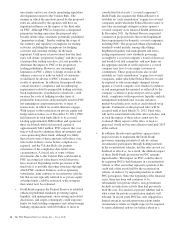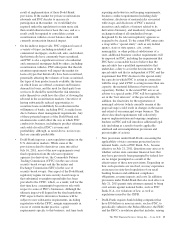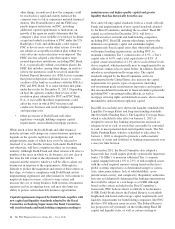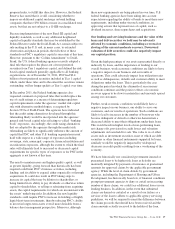PNC Bank 2011 Annual Report Download - page 16
Download and view the complete annual report
Please find page 16 of the 2011 PNC Bank annual report below. You can navigate through the pages in the report by either clicking on the pages listed below, or by using the keyword search tool below to find specific information within the annual report.
regulations that impact the business and financial communities
in general, including changes to the laws governing taxation,
antitrust regulation and electronic commerce.
There are numerous rules governing the regulation of financial
services institutions and their holding companies.
Accordingly, the following discussion is general in nature and
does not purport to be complete or to describe all of the laws
and regulations that apply to us. To a substantial extent, the
purpose of the regulation and supervision of financial services
institutions and their holding companies is not to protect our
shareholders and our non-customer creditors, but rather to
protect our customers (including depositors) and the financial
markets in general.
B
ANKING
R
EGULATION AND
S
UPERVISION
On November 22, 2011, the Federal Reserve adopted a final
rule implementing an annual capital plan review process for
domestic bank holding companies (BHCs) that have $50 billion
or more in total consolidated assets. In addition, on that date,
the Federal Reserve launched its annual review process,
referred to as the Comprehensive Capital Analysis and Review
(CCAR), for 2012. In connection with the 2012 CCAR, and as
part of the annual capital planning process in future years, the
Federal Reserve will undertake a supervisory assessment of the
capital adequacy of the BHCs, including PNC, that have $50
billion or more in total consolidated assets. This capital
adequacy assessment will be based on a review of a
comprehensive capital plan submitted by each participating
BHC to the Federal Reserve. In connection with the 2012
CCAR, PNC filed its capital plan with the Federal Reserve on
January 9, 2012.
The Federal Reserve will evaluate PNC’s capital plan based
on PNC’s risk profile and the strength of PNC’s internal
capital assessment process under the regulatory capital
standards currently applicable and in accordance with PNC’s
plans to address proposed revisions to the regulatory capital
framework developed by the Basel Committee on Banking
Supervision (Basel III) and as set forth in relevant provisions
of Dodd-Frank. The Federal Reserve’s evaluation will take
into consideration any capital distribution plans, such as plans
to pay or increase common stock dividends or to reinstate or
increase common stock repurchase programs. In conducting
this analysis, the Federal Reserve will consider the projected
capital adequacy and performance of PNC under base case
and adverse economic scenarios developed by both PNC and
the Federal Reserve. After completing its review, the Federal
Reserve may object or not object to the firm’s proposed
capital actions. The Federal Reserve has stated that, after
completion of the 2012 CCAR exercise, it expects to publish
the Federal Reserve’s estimates of certain capital, revenue and
loss information under the Federal Reserve’s own supervisory
stress scenario for each of the largest 19 BHCs participating in
the 2012 reviews, including PNC.
PNC expects to receive the Federal Reserve’s response (either
a non-objection or objection) to the capital plan submitted as
part of the 2012 CCAR by the end of the first quarter 2012.
The Basel III capital framework has yet to be finalized by the
Federal banking agencies and is therefore subject to further
change. Using management’s assumptions relevant to
calculation of ratios under Basel III, PNC expects its proforma
Tier 1 common ratio under Basel III to reach about 8.0 to 8.5
percent during 2013. This estimate is based on available data
and information as of December 31, 2011 and on the phase-in
of Basel III rules. It also represents our assumptions and
interpretations regarding the Basel II advanced measurement
approaches regarding the calculation of risk-weighted assets
related to credit, operational and market risk. Both our Basel
II and Basel III estimates are point in time estimates and will
be subject to both further regulatory guidance and clarity, and
the refinement of internal estimates and methodologies.
As a result of Dodd-Frank, subsidiaries of PNC Bank, N.A.
will be subject to state law and regulation to the same extent
as if they were not subsidiaries of a national bank.
Additionally, based on Dodd-Frank, state authorities may
assert that certain state consumer financial laws that provide
different requirements or limitations than Federal law may
apply to national banks, including PNC Bank, N.A. Such state
laws may be preempted if they meet certain standards set forth
in Dodd-Frank or other applicable law.
Dodd-Frank established the 10-member inter-agency Financial
Stability Oversight Council (FSOC), which is charged with
identifying systemic risks and strengthening the regulation of
financial holding companies and certain non-bank companies
deemed to be “systemically important” and could, in
extraordinary cases and in conjunction with the Federal
Reserve, break up financial firms that are deemed to be “too
big to fail.” Dodd-Frank also requires the Federal Reserve to
establish prudential standards for bank holding companies
with total consolidated assets equal to or greater than $50
billion that are more stringent than the standards and
requirements applicable to bank holding companies with
assets below this threshold, and that increase in stringency for
bank holding companies that present heightened risk to the
financial system. Additional information concerning these
enhanced prudential standards is provided in Item 1A of this
Report. The FSOC may make recommendations to the Federal
Reserve concerning the establishment and refinement of these
prudential standards and reporting and disclosure
requirements.
Because of PNC’s ownership interest in BlackRock,
BlackRock is subject to the supervision and regulation of the
Federal Reserve.
Parent Company Liquidity and Dividends. The principal
source of our liquidity at the parent company level is
The PNC Financial Services Group, Inc. – Form 10-K 7


